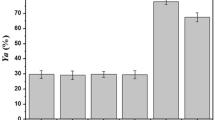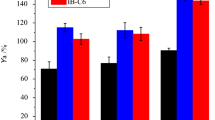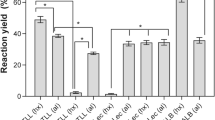Abstract
In this paper, solid-phase chemical amination was applied to enrich the surface of Geotrichum candidum lipase (GCL) with amino groups. The aminated enzyme was slightly thermostabilized and showed a different activity profile at different pH in relation to the non-aminated enzyme. Furthermore, the chemical modification allowed the enzyme to be rapid and easily immobilized on carboxymethyl and sulfopropyl agarose-based supports. The cationically exchanged derivatives presented higher thermostability and higher stability at alkaline pH than the soluble aminated enzyme. In addition, the carboxymethyl derivative was 5.4-, 8.7- and 9.1- and the sulfopropyl derivative was 6.6-, 11.7- and 10.7-fold more stable than the free aminated enzyme in methanol, propanol and cyclohexane, respectively. The ionic derivatives were applied for fish oil hydrolysis in organic aqueous medium at 37 °C. After 72 h of reaction, Omega-3 production corresponded to 354 and 482 μM using the carboxymethyl and sulfopropyl derivatives, respectively. These derivatives resulted, respectively, in 2.4- and 3.2-fold increased fish oil hydrolysis when compared to the soluble aminated lipase. After the reaction, carboxymethyl derivative presented 6.65 U per gram of support and sulfopropyl derivative showed 7.85 U per gram of support, making them attractive for industrial application.






Similar content being viewed by others

References
Kahveci D, Xu X (2011) Repeated hydrolysis process is effective for enrichment of omega-3 polyunsaturated fatty acids in salmon oil by Candida rugosa lipase. Food Chem 129:1552–1558
Botino NR, Vandenbu GA, Reiser R (1967) Resistance of certain long-chain polyunsaturated fatty acids of marine oils to pancreatic lipase hydrolysis. Lipids 2:489–493
Carlson S, Neuringer, M (1999) Polyunsaturated fatty acid status and neurodevelopment: A summary and critical analysis of the literature. Lipids 1999 34:171–178.
Ruxton CHS, Calder PC, Reed SC, Simpson MJA (2005) The impact of long-chain n-3 polyunsaturated fatty acids on human health. Nutr Res Rev 18:113–129
Riediger ND, Othman RA, Suh M, Moghadasian MH (2009) A systemic review of the roles of n-3 fatty acids in health and disease. J Am Diet Assoc 109:668–679
Yashodhara BM, Umakanth S, Pappachan JM, Bhat SK, Kamath R, Choo BH (2009) Omega-3 fatty acids: A comprehensive review of their role in health and disease. J Postgrad Med 85:84–90
Fernández-Lorente G, Pizarro C, López-Vela D, Betancor L, Carrascosa AV, Pessela BC, Guisán JM (2011) Hydrolysis of fish oil by lipases immobilized inside porous supports. J Am Oil Chem Soc 88:819–826
Mateo C, Palomo JM, Fernandez-Lorente G, Guisán JM, Fernandez-Lafuente R (2007) Improvement of enzyme activity, stability and selectivity via immobilization techniques. Enzyme Microb Technol 40:1451–1463
Mateo C, Abian O, Ernedo MB, Cuenca E, Fuentes M, Fernandez-Lorente G et al (2005) Some special features of glyoxyl supports to immobilize proteins. Enzyme Microb Technol 37:456–462
Abian O, Grazu V, Hermoso J, Gonzalez R, Garcia JL, Fernandez-Lafuente R et al (2004) Stabilization of penicillin G acylase from Escherichia coli: site-directed mutagenesis of the protein surface to increase multipoint covalent attachment. Appl Environ Microbiol 70:1249–1251
Hernandez K, Fernandez-Lafuente R (2011) Control of protein immobilization: Coupling immobilization and site-directed mutagenesis to improve biocatalyst or biosensor performance. Enzyme Microb Technol 48:107–122
Fuentes M, Maquiese JV, Pessela BCC, Abian O, Fernández-Lafuente R, Mateo C, Guisán JM (2004) New cationic exchanger support for reversible immobilization of proteins. Biotechnol Prog 20:284–288
Fernández-Lorente G, Godoy CA, Mendes AA, Lopez-Gallego F, Grazu V, Rivas B, Palomo JM, Hermoso JM, Fernandez-Lafuente R, Guisán JM (2008) Solid-phase chemical amination of a lipase from Bacillus thermocatenulatus to improve its stabilization via covalent immobilization on highly activated glyoxyl-agarose. Biomacromol 9:2553–2561.
Rueda N, Santos JCS, Ortiz C, Torres R, Barbosa O, Rodrigues RC, Berenguer-Murcia Á, Fernandez-Lafuente R (2016) Chemical modification in the design of immobilized enzyme biocatalysts: drawbacks and opportunities. Chem Rec 16:1436–1455
López-Gallego F, Montes T, Fuentes M, Alonso N, Grazu V, Betancor L et al (2005) Improved stabilization of chemically aminated enzymes via multipoint covalent attachment on glyoxyl supports. J Biotechnol 116:1–10
Perfetti RB, Anderson CD, Hall PL (1976) The chemical modification of papain with 1-ethyl-3-(3-dimethylaminopropyl) carbodiimide. Biochem 15:1735–1743.
Matyash LF, Ogloblina OG, Stepanov VM (1973) Modification of carboxyl groups in pepsin. Eur J Biochem 35:540–545
Rueda, N, Dos Santos, JCS, Ortiz, C, Barbosa, O, Fernandez-Lafuente, R, Torres, R (2016) Chemical amination of lipases improves their immobilization on octyl-glyoxyl agarose beads. Catal Today 259:107–118.
Rodrigues RC, Barbosa O, Ortiz C, Berenguer-Murcia Á, Torres R, Fernandez-Lafuente R (2014) Amination of enzymes to improve biocatalyst performance: coupling genetic modification and physicochemical tools. RSC Adv 4:38350–38374.
Hoare DG, Olson A, Koshland DE Jr (1968) The reaction of hydroxamic acids with water-soluble carbodiimides. A lossen rearrangement. J Am Chem Soc 90:1638–1643
Nakajima N, Ikada Y (1995) Mechanism of amide formation by carbodiimide for bioconjugation in aqueous media. Bioconjug Chem 6:123–130
Morais Júnior WG, Ribeiro EJ, Cardoso VL, Resende MM, Kamimura ES, Pessela BC (2016) Optimization of the production and characterization of lipase from Candida rugosa and Geotrichum candidum in soybean molasses by submerged fermentation. Protein Expr Purif 123:26–34
Quinn DM, Shirai K, Jackson RL, Harmony JAK (1982) Lipoprotein lipase catalyzed hydrolysis of water-soluble p-nitrophenyl esters. Inhibition by apoprotein C-II. Biochem 21:6872–6879.
Bastida A, Sabuquillo P, Armisen P, Fernandez-Lafuente R, Huguet J, Guisán JM (1998) A single step purification, immobilization, and hyperactivation of lipases via interfacial adsorption on strongly hydrophobic supports. Biotechnol Bioeng 58(5):486–493
Bradford MM (1976) A rapid and sensitive method for the quantitation of microgram quantities of protein utilizing the principles of protein-dye biding. Anal Biochem 72:248–254
Galvis M, Barbosa O, Torres R, Ortiz C, Fernandez-Lafuente R (2012) Effect of solid phase chemical modification on the features of the lipase from Thermomyces lanuginosus. Process Biochem 47:460–466
Horikawa S, Ogawara H (1979) A simple and rapid procedure for removal of Triton X-100 from protein solution. Anal Biochem 97:116–119.
Palomo JM, Fernandez-Lorente G, Guisan JM, Fernandez-Lafuente R (2007) Modulation of immobilized lipase enantioselectivity via chemical amination. Adv Synth Catal 349:1119–1127
Cabrera Z, Fernandez-Lorente G, Fernandez-Lafuente R, Palomo JM, Guisan JM (2009) Enhancement of Novozym-435 catalytic properties by physical or chemical modification. Process Biochem 44:226–231
Rodrigues RC, Godoy CA, Volpato G, Ayub MAZ, Fernandez-Lafuente R, Guisán JM (2009) Immobilization-stabilization of the lipase from Thermomyces lanuginosus: critical role of chemical amination. Process Biochem 44:963–968
Godoy CA, de las Rivas B, Guisán JM (2014) Site-directing an intense multipoint covalent attachment (MCA) of mutants of the Geobacillus thermocatenulatus lipase 2 (BTL2): genetic and chemical amination plus immobilization on a tailor-made support. Process Biochem 49(8):1324–1331
Montes T, Grazu V, López-Gallego F, Hermoso JA, Guisán JM, Fernandez-Lafuente R (2006) Chemical modification of protein surfaces to improve their reversible enzyme immobilization on ionic exchangers. Biomacromol 7(11):3052–3058
Gómez L, Ramírez HL, Neira-Carrillo A, Villalonga R (2006) Polyelectrolyte complex formation mediated immobilization of chitosan-invertase neoglycoconjugate on pectin-coated chitin. Bioprocess Biosys Eng 28(6):387–395
Palomo J M, Muñoz G, Fernández-Lorente G, Mateo C, Fernández-Lafuente R, Guisán JM (2002) Interfacial adsorption of lipase on very hydrophobic support (octadecyl-Sepabeads): immobilization, hyperactivation and stabilization of the open form of lipases. J Mol Catal B Enzym 19–20:279–286
Bezbradica D, Jugovic B, Gvozdenovic M, Jacovetic S, Knezevic-Jugovic Z (2011) Electrochemically synthesized polyaniline as support for lipase immobilization. J Mol Catal B Enzym 70:55–60
Moreno-Perez S, Ghattas N, Filice M, Guisán JM (2015) Dramatic hyperactivation of lipase of Thermomyces lanuginosus by a cationic support: fixation of the hyperactivated form by adsorption on sulfopropyl-Sepharose. J Mol Catal B Enzym 122:199–203
Betancor L, Lopez-Gallego F, Hidalgo A, Alonso-Morales N, Fuentes M, Fernandez-Lafuente R, Guisán JM (2004) Prevention of interfacial inactivation of enzymes by coating the enzyme surface with dextran-aldehyde. J Biotechnol 110:201–207
Schmitt-Rozieres M, Deyris V, Comeau LC (2000) Enrichment of polyunsaturated fatty acids from fish cannery effluents by enzymatic selective esterification. J Oil Fat Ind 77:329–332
Pérez SM, Martin S, Fernández-Lorente G, Filice M, Guisán JM, Ventosa A, Garcia MT, Mellado E (2011) A novel halophilic lipase, LipBL, with applications in synthesis of eicosapentaenoic acid (EPA). PLoS One 6:1–11
Pereira MG, Facchini FDA, Polizeli AM, Vici AC, Jorge JA, Pessela BC, Fernández-Lorente G, Guisán JM, Polizeli MLTM (2015) Stabilization of lipase of Hypocrea pseudokoningii by multipoint covalent immobilization after chemical modification and application of the biocatalyst in oil hydrolysis. J Mol Catal B Enzym 121:82–89
Acknowledgements
The authors wish to thank CAPES (Brazil) for financial support through the PDSE Program (BEX 14174/13-8) and the “Instituto de Investigación en Ciencia de la Alimentación” (CIAL) for supporting this project.
Author information
Authors and Affiliations
Corresponding author
Ethics declarations
Conflict of interest
The authors declare that they have no conflict of interest.
Ethical approval
This article does not contain any studies with human or animal subjects.
Rights and permissions
About this article
Cite this article
de Morais Júnior, W.G., Terrasan, C.R.F., Fernández-Lorente, G. et al. Solid-phase amination of Geotrichum candidum lipase: ionic immobilization, stabilization and fish oil hydrolysis for the production of Omega-3 polyunsaturated fatty acids. Eur Food Res Technol 243, 1375–1384 (2017). https://doi.org/10.1007/s00217-017-2848-8
Received:
Revised:
Accepted:
Published:
Issue Date:
DOI: https://doi.org/10.1007/s00217-017-2848-8



